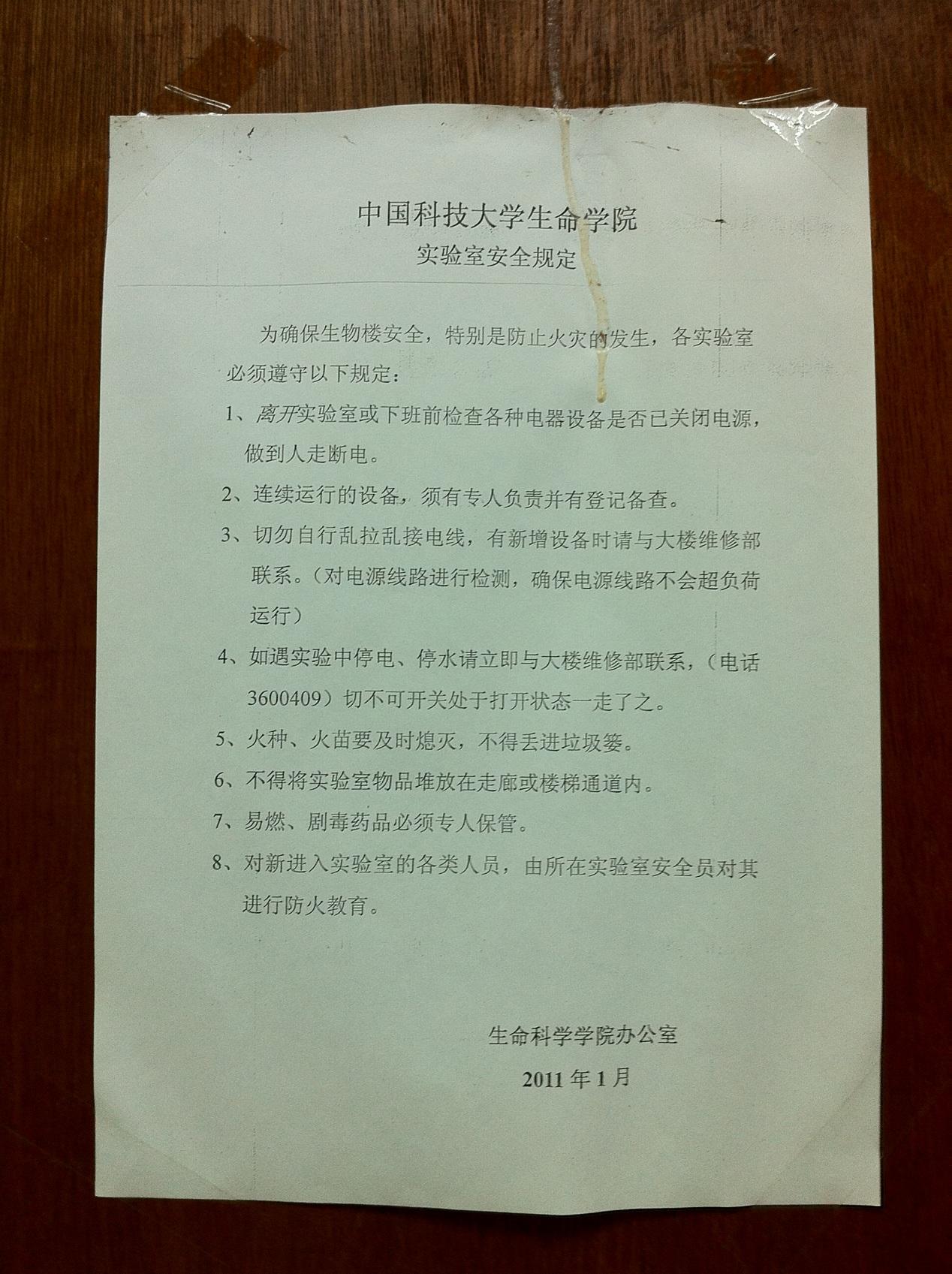Team:USTC-China/Safety/overview
From 2011.igem.org
Safety Proposal
1. Would the materials used in your project and/or your final product pose: a. Risks to the safety and health of team members or others in the lab?
The main purpose of our project is to regulate some of the kinetic properties of E. coli, which is not much concerned with the toxicity of the bacteria. However, it is never too overreacting to keep a warning bell in mind. Just in case our experiments may bring about uneasiness of safety, we have taken measures to make sure people inside the laboratory and in the outside world don’t get hurt. Several rules are established for everyone to stick to such as protective gears are required while performing experiments, and poisonous and reactive reagents should be used in special areas. We are using separate and distant spaces to perform experiments and study. Also before the whole project started we had a specific and detailed safety training for both USTC and USTC Software team members since we are using the same laboratory.
Ethidium bromide, an intercalating agent used as a nucleic acid fluorescent stain, will be and only be applied in electrophoretic procedures during our whole project. Anyone performing the procedure is asked to be wearing nitrile gloves all the time and no other thing is allowed to be done in the same area. The used agarose gels are carefully collected and thrown away after experiments.
Ultraviolet light are used during sterilization and decontamination of culture medium as well as visualizing the stained DNA in the electrophoretic gels. We are making rules against direct exposition to UV radiation such as special safety lenses would be used and the machine we use to visualize electrophoretic gels is UV-blocking.
b. Risks to the safety and health of the general public if released by design or accident?
Since the strains we use in the whole study is not related to the genes of plants, animals or human and no pathogenic or toxic genes are being used during experiments, it is not likely that our materials or products will threaten the safety and health of the general public. Nevertheless the regulations of Genetically Engineered Organisms (GMOs) made by relevant departments of P. R. China will be followed.
c. Risks to environmental quality if released by design or accident?
For the safety of the environment, we managed to classify all the experimental waste due to the environmental demands of the institute to prevent unwanted genes, if any, from contaminating the world around us. And since our project only concerns with the kinetic properties of bacteria, it is of no harm to the environment.
d. Risks to security through malicious misuse by individuals, groups or states? Taking into account that our team is aimed at changing some specific characters of bacteria, and the strains we are using are neither pathogenic nor toxic, no risks to security will be posed.
Please explain your responses (whether yes or no) to these questions.
Specifically, are any parts or devices in your project associated with (or known to cause):
- pathogenicity, infectivity, or toxicity? No.
- threats to environmental quality? No.
- security concerns? No.
2. If your response to any of the questions above is yes: a. Explain how you addressed these issues in project design and while conducting laboratory work. b. Describe and document safety, security, health and/or environmental issues as you submit your parts to the Registry.
3. Under what biosafety provisions will / do you operate? a. Does your institution have its own biosafety rules and if so what are they? Provide a link to them online if possible. Our institution has its own lab safety rules. We have them put up in a very evident part in our laboratory.
b. Does your institution have an Institutional Biosafety Committee or equivalent group? If yes, have you discussed your project with them? Describe any concerns or changes that were made based on this review. Our institution does not have a committee or group like that, but our instructors and advisors have made suggestions for the good of biosafety. According to their advice we are now using separate zones to study and performing experiments. c. Will / did you receive any biosafety and/or lab training before beginning your project? If so, describe this training. Yes. We had a winter workshop before launching our project. The team members of iGEM 2010 taught us the basic information about how to get good results without getting hurt. d. Does your country have national biosafety regulations or guidelines? If so, provide a link to them online if possible. Our state government has set rules and regulations on biosafety, laboratories working on pathogenic microbes are registered and under strict surveillance. We also evaluate our experimental process according to the regulations put forth by relevant departments of P. R. China. To get the detailed information please visit: National Biosafety Clearing-House of China:http://english.biosafety.gov.cn/ Biosafety regulation on pathogenic microbes: http://www1.www.gov.cn/zwgk/2005-05/23/content_256.htm
4. OPTIONAL QUESTION: Do you have other ideas on how to deal with safety or security issues that could be useful for future iGEM competitions? How could parts, devices and systems be made even safer through biosafety engineering?
This year our team has developed an innovative way to deal with the safety problems during the study of synthetic biology-- Three Laws of Synthesis Biology. Read as follows: 1. Once an altered plasmid gets into bacteria that does not aim at adopting the plasmid, the suicidal mechanism of the plasmid will be executed. 2. Once the mutation accumulates to a certain degree, the suicide mechanism of the bacteria will be executed. 3. Once an infected bacterium is away from its regular surroundings, the suicide mechanism will be executed. We have illustrated the details in related parts of human practice.
 "
"
